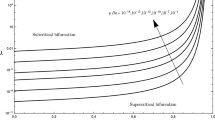Abstract
We examine analytically the Kelvin–Helmholtz stability of two compressible superposed viscous fluids flowing through porous medium. The dispersion relationship is derived and evaluated for special cases adopting the normal mode procedure. The results have been compared with the statics (RTI) and incompressible cases. It is shown that the behaviour of KHI tends to RTI behaviour if the difference in the initial velocity of two fluids (U2 − U1) is small. For incompressible KHI, the kinematic viscosity induces stability. The permeability has also stabilizing role on the perturbation’s growth, but the growth rate increases as permeability increases. The porosity has destabilizing effect on KHI for the case of small values of porosity, while for large values, it has stabilizing effect. The compressibility parameters (the specific heats ratio and pressure at equilibrium state) have stabilizing role on KHI. The behaviour of normalized growth rate of a compressible KHI model with the porosity effect in most cases capitulates to effect of porosity.























Similar content being viewed by others
References
H.L.F. Helmholtz, On the discontinuous movements of fluids. Sitz.ber. Preuss. Akad. Wiss. Berl. Phil.-Hist. Kl 23, 215–228 (1868)
Kelvin Lord, Hydrokinetic solutions and observations. Philos. Mag. 42, 362–377 (1871)
I.E. Alexander, Kelvin–Helmholtz instability in type-1 comet tails and associated phenomena. Space Sci. Rev. 25(1), 3–34 (1980)
A.P. Lobanov, J.A. Zensus, A cosmic double helix in the archetypical quasar 3C273. Science 294, 128–131 (2001)
D.J. Price, S. Rosswog, Producing ultrastrong magnetic fields in neutron star mergers. Science 312, 719–722 (2006)
A. Hasegawa et al., Transport of solar wind into Earth’s magnetosphere through rolled-up Kelvin–Helmholtz vortices. Nature 430, 755–758 (2004)
Amiya K. Sen, Effect of compressibility on Kelvin–Helmholtz instability in a plasma. Phys. Fluids 7, 1293–1298 (1964)
K.M. Srivastava, On the hydromagnetic Kelvin–Helmholtz instability between compressible fluids. Z. Naturforsch 29, 888–892 (1974)
Shivamogg K. Bhimsen, Kelvin–Helmholtz instability of a compressible plasma in a magnetic field. Appl. Sci. Res. 37(3–4), 291–299 (1981)
T.P. Ray, A. Ershkovicht, I: Kelvin-Helmholtz instabilities in a sheared compressible plasma. Mon. Not. R. Astron. Soc. 204, 821–831 (1983)
P. Zu-Yin, G.K. Margaret, Kelvin-Helmholtz instability at the magnetopause: solution for compressible plasmas. J. Geophys. Res.: Space Phys. 88(A2), 841–852 (1983)
Dina Prialnik, A. Eviatar, A.I. Ershkovich, The effect of plasma compressibility on the Kelvin-Helmholtz instability. J. Plasma Phys. 35(2), 209–218 (1986)
M.G. Gudkov, O.A. Troshichev, Kelvin–Helmholtz instability in a compressible plasma with a magnetic field and velocity shear. J. Atmos. Terr. Phys. 58(5), 613423 (1996)
Soler. R., Díaz A.J., Ballester J.L., Goossens M.: Kelvin–Helmholtz instability in partially ionized compressible plasmas. Astrophys. J., 749(2), article id. 163:12 (2012)
M. Karimi, S.G. Sharath, Suppression mechanism of Kelvin–Helmholtz instability in compressible fluid flows Phys. Rev. E 93, 041102(R) (2016)
A. Bejan, P. Vadâsz, D.G. Kroger, Energy and the Environment (Springer, Dordrecht, 1999)
Mujeebua M. Abdul, M.Z. Abdullaha, M.Z. Abu Bakarb, A.A. Mohamadc, M.K. Abdullaha, Applications of porous media combustion technology—A review. Appl. Energy 86(9), 1365–1375 (2009)
Kambiz Vafai, Porous media and its applications in science. Eng. Ind. AIP Conf. Proc. 1453, 1 (2012)
Kambiz Vafai, Handbook of Porous Media, 3rd edn. (Taylor and Francis Group, Routledge, 2015)
Ajay Mandal, Chemical flood enhanced oil recovery: a review. Int. J. Oil Gas Coal Technol. 9(3), 241 (2015)
H.P.G. Darcy, Les fontaines publiques de la ville de Dijon (Victor Dalmont, Paris, 1856)
P.G. Saffman, G. Taylor, The penetration of a fluid into a porous medium or Hele-Shaw cell containing a more viscous liquid. Proc. R. Soc. Lond. Ser. A Math. Phys. Sci. 245(1242), 312–329 (1958)
R. Raghavan, S.S. Marsden, The stability of immiscible liquid layers in a porous medium. J. Fluid Mech. 48(1), 143–159 (1971)
R.C. Sharma, H. Singh, K.P. Thakur, Kelvin—Helmholtz instability through porous medium of two superposed plasmas. Acta Physica Academiae Seientiarum Hungarieae Tomus 48(1), 103–108 (1980)
M.F. El-Sayed, The effects of collisions with neutral particles on the instability of two superposed composite plasmas streaming through porous medium. Z. Naturforsch 54a, 411–416 (1999)
Sharma P. K.: Effect of magnetic field on the conducting fluids streaming in porous medium, International Conference on Recent Trends in Physics (ICRTP 2012) Journal of Physics: Conference Series 365: 012041 (2012)
A. Samanta, R. Vinuesa, I. Lashgari, P. Schlatter, Enhanced secondary motion of the turbulent flow through a porous square duct. J. Fluid Mech. 784, 681–693 (2015)
D. Livescu, Compressibility effects on the Rayleigh–Taylor instability growth between immiscible fluids. Phys. Fluids 16, 118–127 (2004)
G.A. Hoshoudy, Compressibility effects on the Rayleigh–Taylor instability growth between two immiscible fluids through Darcy porous media. J. Porous Media 17(3), 255–265 (2014)
Acknowledgements
The authors would like to thank Prof. Serge Gauthier for his valuable time for reading the manuscripts and providing valuable suggestions and his help to writing the paper, Dr. M. Elsayed (Department of Mathematics and Computer Science, Faculty of Science, South Valley University, Qena, Egypt) for assisting in the revising process. We would like also to thank the referees for their interest in this work and for their many constructive suggestions that improved the original manuscript.
Author information
Authors and Affiliations
Corresponding author
Appendix
Appendix
Rights and permissions
About this article
Cite this article
Hoshoudy, G.A., Awasthi, M.K. Compressibility effects on the Kelvin–Helmholtz and Rayleigh–Taylor instabilities between two immiscible fluids flowing through a porous medium. Eur. Phys. J. Plus 135, 169 (2020). https://doi.org/10.1140/epjp/s13360-020-00160-x
Received:
Accepted:
Published:
DOI: https://doi.org/10.1140/epjp/s13360-020-00160-x



